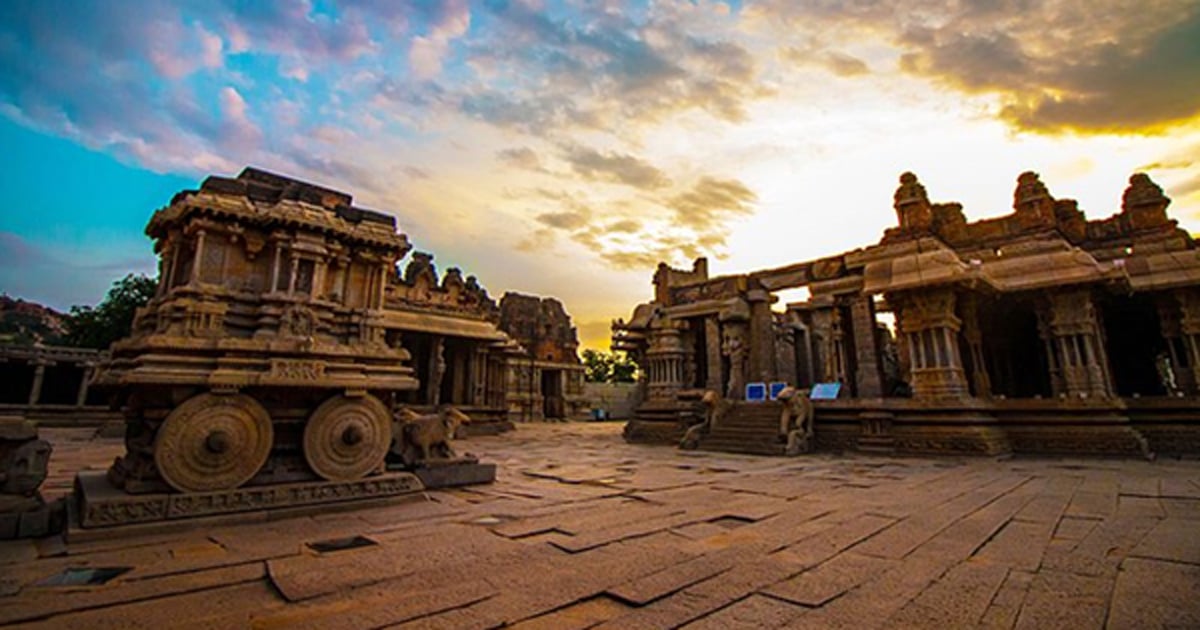- A fictionalised account of the Vijayanagara Kingdom has been published by a British author. He based his accounts on the poet Pampa Kampana, who witnessed many of Vijayanagara’s victories and defeats. The Vijayanagara Empire
- The Vijayanagara kingdom has long piqued historians’ and politicians’ interest.
- The kings of Vijayanagara ruled over a territory of more than 360,000 square kilometres from their capital, now known as Hampi on the banks of the Tungabhadra River.
- The kingdom of Vijayanagara, founded in 1336, lasted for more than three centuries, enduring multiple political stresses and making significant advances in art and economy.
- It was one of the subcontinent’s most powerful kingdoms.

Its framework
- The kingdom experienced many ups and downs during its existence, which lasted from 1336 to 1646.
- Vijayanagara, founded by Harihara I of the Sangama dynasty, grew from a strategic position on the banks of the Tungabhadra River.
- It had grown into a formidable force by the 15th century.
Rise of Krishna Deva Raya I
- Krishna Deva Raya led the kingdom to its pinnacle (reign 1509-1529).
- It was a time when Vijayanagara enjoyed military superiority over rival kingdoms such as the Bahmani Sultanate, the Golconda Sultanate, and the Odisha Gajapatis.
- At its height, the kingdom extended from Goa on the Konkan coast to parts of southern Odisha in the east and all the way to the subcontinent’s southernmost tip in the south.
Why is the history of Vijayanagara so revered?
- Monetized economy: Coins were minted by the state as well as by merchant guilds using gold, silver, copper and brass, and their value depended on material weight.
- Pepper, ginger, cinnamon, cardamom, myrobalan, tamarind timber, anafistula, precious and semi-precious stones, pearls, musk, ambergris, rhubarb, aloe, cotton cloth, and porcelain were the Empire’s main exports.
- Maritime trade: While the kingdom’s economy was primarily based on agriculture, trade thrived in its many ports on either coast. Abd al-Razzaq Samarqandi, a traveller, described how the ports of Mangalore, Honavar, Bhatkal, Barkur, Cochin, Cannanore, Machilipatnam, and Dharmadam welcomed traders from Africa, Arabia, Aden, the Red Sea, China, and Bengal, as well as serving as shipbuilding centres.
Vijayanagara’s contributions to culture and architecture
(1) Literary development
- The Vijayanagar Empire was also well-known for its vibrant culture and literature.
- Many poets and scholars wrote in both Sanskrit and Kannada at the court.
- The Amuktamalyada and the Jambavati Kalyanam were written by the emperor Krishnadevaraya, who was also a poet.
- The Vijayanagar Empire also supported the arts, which resulted in a boom in music, dance, and painting.
(2) Architectural development
- Today, the capital of Vijayanagara, Hampi, is a UNESCO World Heritage Site known for its sophisticated fortifications as well as numerous temples and other architectural marvels.
- According to foreign travel accounts, by the early 16th century, Hampi-Vijayanagara was probably the world’s second largest urban settlement (after Beijing) and one of the most prosperous.
- The iconic Vitthala temple complex in Hampi was the most impressive architectural feat of the Vijayanagar Empire.
- A temple dedicated to the god Vitthala, a large audience hall, and a stone chariot shrine comprise this complex.
- Bukka I’s Prasanna Virupaksha temple and Krishna Deva Raya’s Hazara Rama temple are both striking examples of Vijayanagara’s distinctive style and intricate artistry.
Causes of its decline
- Military defeats: The Vijayanagara Empire suffered its first major defeat at the Battle of Talikota in 1565, when it was defeated by a coalition of Muslim sultanates. This major defeat severely weakened the Vijayanagara Empire, ushering in a period of political unrest and civil war.
- Economic disruption: The Deccan Sultanates’ policy of destroying Vijayanagara’s economy and trade networks exacerbated this. As a result, the empire’s political power was diminished, as was its ability to defend itself against future attacks.
- Internal conflict: Other factors that contributed to the conflict included internal divisions among ruling families and the rise of local governors who declared their independence.
Various Vijayanagara kingdom travel details
- Vasco da Gama (Vasco da Gama): The first European traveller to encounter the Vijayanagara Empire was the Portuguese explorer Vasco da Gama, who visited the kingdom in 1498 and was the first to recognise its wealth and power.
- Conti, Nicolo: The Italian traveller Nicolo Conti visited the kingdom in 1420 and documented his journey in a book titled “Viaggio in India”. He wrote about the splendour of the cities and the kingdom’s wealth.
- Van Linschoten, Jan Huyghen: Jan Huyghen van Linschoten, a Dutch traveller, visited the kingdom in 1583 and wrote a book titled “Itinerario” about his journey. He wrote about the magnificent forts, magnificent temples, thriving markets, and grand palaces.
- Jean-Baptiste Tavernier: In 1665, the French traveller Jean-Baptiste Tavernier visited the kingdom and published “Les Six Voyages de Jean-Baptiste Tavernier,” a book about his journey. He wrote about the fine architecture, the grandeur of the palaces, and the kingdom’s wealth and prosperity.
- Robert Orme: In 1770, the English traveller Robert Orme visited the kingdom and wrote a book titled “Military Transactions in India” about his experience. He wrote about the empire’s size and scope, the splendour of its cities, and the kingdom’s advanced military technology.
Source: https://www.britannica.com/place/India/The-Vijayanagar-empire-1336-1646
